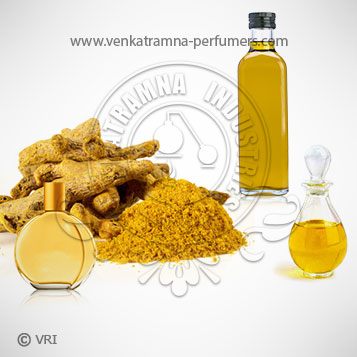
| Botanical Name | Curcuma Longa |
| Common Name | Curcuma longa. |
| Country of Origin | India, China, Indonesia, Jamaica, Haiti |
| Solubility | soluble in alcohol, insoluble in water |
| Specific Gravity | 0.9160-0.9366 |
| Optical Rotation | -24 – -27 @ 20°C |
| Refrective Index | 1.5023-1.5138 @ 20 c |
| PlantPart | Rhizomes of the plant |
| Bland With | Elecampane, ginger, labdanum and musk. |
| CAS No | 8024-37-1 |
| Flash Point | 60 °C |
| Extraction Method | Steam Distilled |
Turmeric Oil is much popular for its medicinal as well as coloring and flavoring properties. It is extracted from the turmeric plant which is widely cultivated because of its utility as a yellow-orange culinary spice. Curcuma longa, a medicinal tuber plant belonging to this family, is a close relative of Curcuma zedoaria from which the curcumin is isolated. Various parts of Curcuma are used in Ayurveda and other folk and tribal system of medicines. The rhizome is used for curing stomach diseases, toothache, blood stagnation, leucoderma, tuberculosis, enlargement of spleen, and for promoting menstruation in traditional medicine in Asia. Anti-inflammatory activity, antifungal activity, antiulcer activity, antimicrobial effect, hepatoprotective activity, antiamoebic effect, of this plant rhizome have been reported.
A member of the Ginger family, Turmeric is a well familiar spice of Asian cuisine. It is best known for its bright yellow colour, which gives curry powder its characteristic appearance. Turmeric has a long history of use, not just as a spice, but also as a healing agent and as a magical herb. When Europeans were first introduced to it they often falsely identified it as Saffron. However, while it serves perfectly as a dye for all sorts of substances, its properties and flavour do no not compare to those of Saffron. In India Turmeric is indeed widely used as dye, not just for ritual foods to be offered to the Gods, but also for textiles (Buddhist robes are traditionally dyed with Turmeric). Carbonate of soda helps to fix the dye, though it is not very permanent. Occasionally it is also used cosmetically as make-up at weddings and other festive events. The food industry employs it as a colorant for cheeses, sausage and confectionary. The use of turmeric dates back nearly 4000 years to the Vedic culture in India, where it was used as a culinary spice and had some religious significance. It probably reached China by 700 AD, East Africa by 800 AD, West Africa by 1200 AD, and Jamaica in the eighteenth century. In 1280, Marco Polo described this spice, marveling at a vegetable that exhibited qualities so similar to that of saffron. According to Sanskrit medical treatises and Ayurvedic and Unani systems, turmeric has a long history of medicinal use in South Asia. Susruta’s Ayurvedic Compendium, dating back to 250 BC, recommends an ointment containing turmeric to relieve the effects of poisoned food.
Color : Pale yellow to reddish-brown oily liquid with spicy, fresh woods aroma,
Aroma : This oil has a very spicy and a woody fragrance.
Curcumin, zingiberine, ketone, essential oils, phellandrene, limonene, ar-turmerone, a-turmerone, ß-turmerone, 1,8-cineole.
Turmeric oil again is very much used in the pharmaceutical industry because of its role in relieving all kinds of pain, anxiety and stress; fighting physical and mental depression, etc. It also is a popular insect repellant. The benefits of turmeric on the skin have been well proved. Turmeric is a plant that has a very long history of medicinal use, dating back nearly 4000 years. In Southeast Asia, turmeric is used not only as a principal spice but also as a component in religious ceremonies. In folk medicine, turmeric has been used in therapeutic preparations over the centuries in different parts of the world. In Ayurvedic practices, turmeric is thought to have many medicinal properties including strengthening the overall energy of the body, relieving gas, dispelling worms, improving digestion, regulating menstruation, dissolving gallstones, and relieving arthritis. Many South Asian countries use it as an antiseptic for cuts, burns, and bruises, and as an antibacterial agent. In Pakistan, it is used as an anti-inflammatory agent, and as a remedy for gastrointestinal discomfort associated with irritable bowel syndrome and other digestive disorders. In Pakistan and Afghanistan, turmeric is used to cleanse wounds and stimulate their recovery by applying it on a piece of burnt cloth that is placed over a wound. Indians use turmeric, in addition to its Ayurvedic applications, to purify blood and remedy skin conditions. Turmeric paste is used by women in some parts of India to remove superfluous hair. Turmeric paste is applied to the skin of the bride and groom before marriage in some parts of India, Bangladesh, and Pakistan, where it is believed to make the skin glow and keep harmful bacteria away from the body. Turmeric is currently used in the formulation of several sunscreens. Several multinational companies are involved in making face creams based on turmeric.